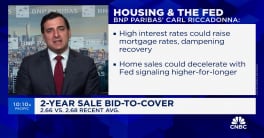Freddie Mac and Fannie Mae may have recently come to appreciate the old saw "be careful what you wish for."
A year or so ago Federal Reserve Chairman Alan Greenspan was giving the two government sponsored enterprises (GSEs) a lot of grief about their loan portfolios, particularly in light of the trouble that both had gotten into with accounting irregularities and the regulatory requirements to increase their capital reserves. It is likely that the executives of both corporations were counting the days until Greenspan's scheduled retirement.
So, retire he did, only to be replaced by Ben Bernanke. On Tuesday Bernanke,
speaking to a convention of the Independent Community Bankers of America called
for reforms to the system that have probably sent Fannie Mae CEO Roger Mudd
and Freddie Mac CEO Richard F. Syron into an extreme case of the vapors.
Bernanke directed his remarks to what he called the GSEs' "second line
of business." The first line is its role purchasing mortgages from
originators and packaging them into mortgage backed securities (MBS), backing
them with guarantees and them selling them to investors, thus increasing the
liquidity of the residential mortgage market which, Bernanke said, has made
mortgage credit more widely available, especially to low and middle-income borrowers.
His criticism was leveled at the purchase of mortgage-backed securities and other types of assets for the GSEs' own investment portfolios. This line of business, he said, owes its fundamental source of profitability to the perception that the federal government would not allow a GSE to fail. This erroneous perception of government guarantees allows the GSEs to borrow at interest rates below that paid by other private participants in mortgage markets. "By borrowing at this preferential rate and purchasing assets (including MBS) that pay returns considerably greater than the Treasury rate, the GSEs can enjoy profits of an effectively unlimited scale". This, Bernanke said, provides the GSEs the incentive both to expand the range of assets that they acquire and to increase the size of their portfolios to the greatest extent possible.
Bernanke discounted the GSE argument that their purchases provide additional support to the mortgage market (although he also said that for the purpose of his remarks he would stipulate that the portfolios may serve to enhance liquidity and reduce costs in some circumstances) and said that these large portfolios are subject to significant volatility and financial risk. The Federal Reserve Board and others, he said, have expressed concern that these portfolios may provide systemic risk to the performance of the broader economy.
He explained that there are two conditions that are common to most episodes of financial crisis: they usually involve financial institutions or markets that are either very large or play a critical role in the financial system and, second the origins (other than in crises caused by non-financial events such as war) can be traced to failures of due diligence or "market discipline" by an important group of market participants. Bernanke said that both of these conditions apply to the Fannie and Freddie situation today. They are certainly large, holding 20 percent of outstanding residential mortgages worth $1.56 trillion in 2003. In 2005 the two GSEs together had $5.2 trillion in debt and MBS obligations outstanding. By comparison, the U.S. government has $4.9 trillion in publicly held debt. The GSEs also engage in extensive hedging activities and consequently are among the most active users of derivative instruments.
"In most situations," the Fed chairman said, "policymakers can rely on market forces to constrain the risk-taking behavior of privately owned financial organizations." This discipline is effective because creditors have powerful incentives to monitor the risk-taking and risk-management activities of their debtors and, if increased risk is suspected they will reduce their exposure to the organization or demand greater compensation for bearing additional risk. Thus market responses act as a brake on an organization's risk-taking behavior and reduce the likelihood of failure.
But, he explained, unlike other private firms, the GSEs face little or no market discipline from their senior debt holders because of the belief among market participants that the U.S. government will not allow the GSEs to fail. Therefore, increased risk-taking does not significantly increase the GSEs' cost of funding or reduce their access to credit. Indeed GSE debt trades at a narrow spread over U.S. Treasury debt and below those of other highly rated financial institutions, including the largest U.S. bank holding companies and that spread has been remarkably unresponsive to the recent problems of the GSEs.
All of these factors --the large presence of the GSEs in financial markets, the lack of market discipline exercised by GSE investors, and the incentives for continued portfolio growth-- led to a conclusion by the Federal Reserve that while the GSEs do not seem to pose an immediate risk of financial difficulty, their portfolios continue to represent a potentially significant source of systemic risk.
Bernanke also cited the low capital-to-assets ratio of the GSE holdings. The largest bank holding companies generally hold capital equal to 6 percent of assets and large regional banks generally have capital ratios of about 8 percent. In comparison, the GSEs hold capital equal to roughly 3.5 percent of assets.
Chairman Bernanke laid out several suggestions for reducing the inherent risk of the GSEs and promoting the public purposes they serve:
- The GSE regulator should have the authority necessary to set and adjust GSE capital requirements in line with the risks posed by the GSEs.
- The GSEs should be subject to a clear and credible receivership process, a process that would establish that both shareholders and debt holders of a failed GSE would suffer financial losses thus providing an incentive for market discipline.
- The GSEs' portfolios should be anchored firmly to a well-understood public purpose approved by the Congress.
The third point, that GSE portfolios should be anchored to a clear and well-defined public purpose would help to ensure that society in general--not just GSE shareholders--receives a meaningful return in exchange for accepting the risks inherent in the portfolios and would reduce the potential for their unbridled growth while avoiding the imposition of arbitrary limits or caps.
Bernanke said an obvious and worthy candidate for a public purpose is the promotion of affordable housing. While Congress has established goals for the GSEs to meet in this area it is difficult to find evidence that they have had beneficial effects beyond those arising from their securitization activities for the overall mortgage market. Indeed, the GSE regulator estimates that less than 30 percent of current portfolio holdings are "oriented toward affordable housing."
To require the GSEs to focus their portfolios almost exclusively on mortgages or mortgage-backed securities that support affordable housing would clearly tie them to a public purpose. The market for affordable-housing products--particularly mortgages extended to households with below-median-income--is less deep and liquid than the broader market for residential mortgages and GSE portfolio purchases might add significant liquidity to the secondary markets for such assets, thereby reducing costs and increasing credit availability to prospective home purchasers. In addition, increasing the presence of the GSEs in the market for affordable housing could help banks fulfill their Community Reinvestment Act obligations with greater opportunities for securitizing such loans. Such an approach would set some functional limits on the size of the portfolios and on the range of assets that GSEs would be allowed to purchase, while preserving the ability of these companies to operate profitably.
Bernanke stressed that he was not advocating that the GSEs expose themselves to subprime loans. "Orienting the GSEs' portfolios more toward affordable housing is an approach which can succeed under the current GSE credit standards. Indeed, the credit risks associated with an affordable-housing portfolio need not be any greater than mortgage portfolios generally, so long as the GSEs continue to adhere to sound underwriting practices."







